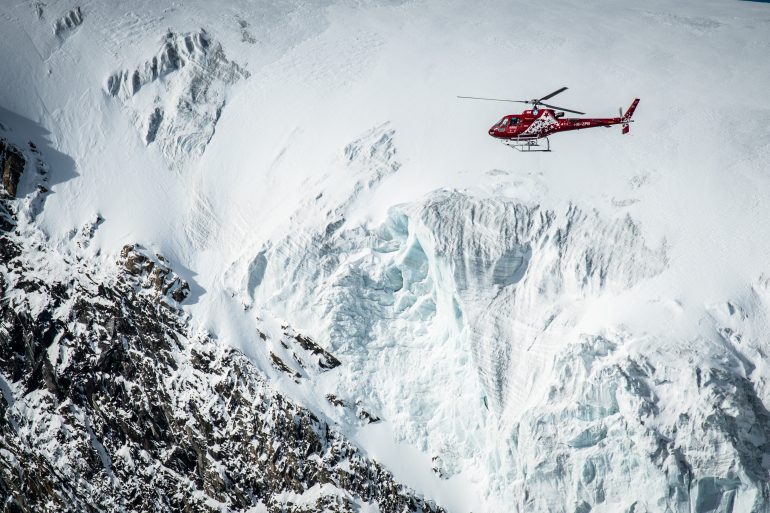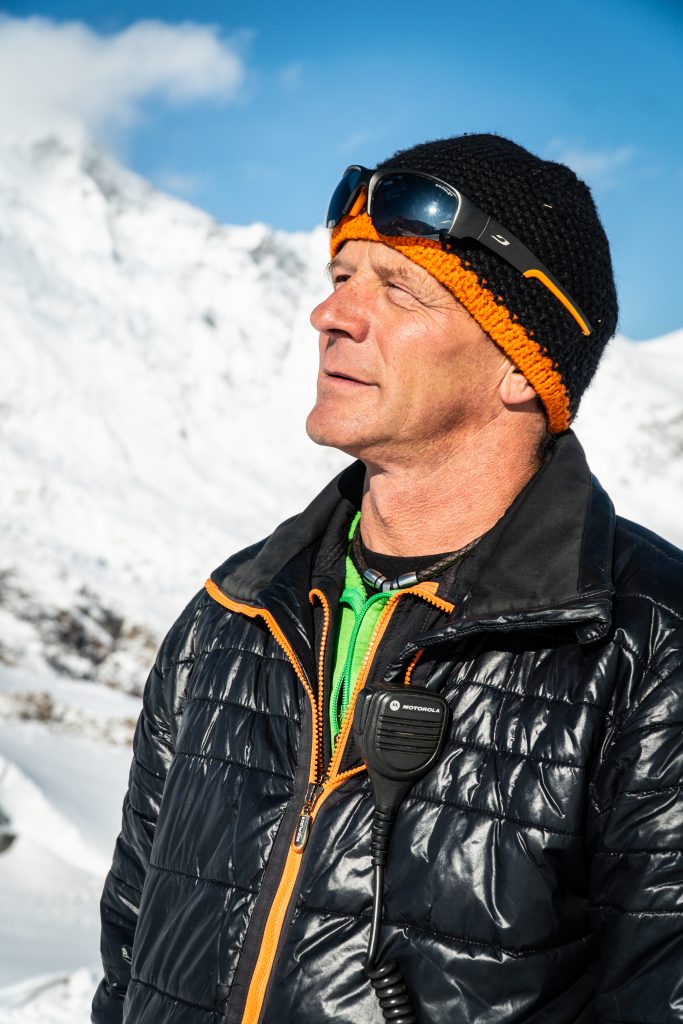“You need nerves of steel”
The last descent belongs to them. They trigger avalanches, position piste markers, and rescue injured skiers. Head of mountain rescue Albert Hegner on danger and his team’s role in ensuring guests can ski safely.
“He needs to turn off the engine.” Bärti, as Albert Hegner is better known, needs to focus. Right now, nothing else matters, not even the helicopter waiting to fly him to his next port of call. An avalanche has damaged a monitoring station. Bärti has to assess the damage and, if possible, repair it on site.
Bärti Hegner, calmness incarnate? He laughs, “Sometimes I’ll lose my cool for five minutes or so… but it never helps.” He always has a plan B – and nerves of steel.
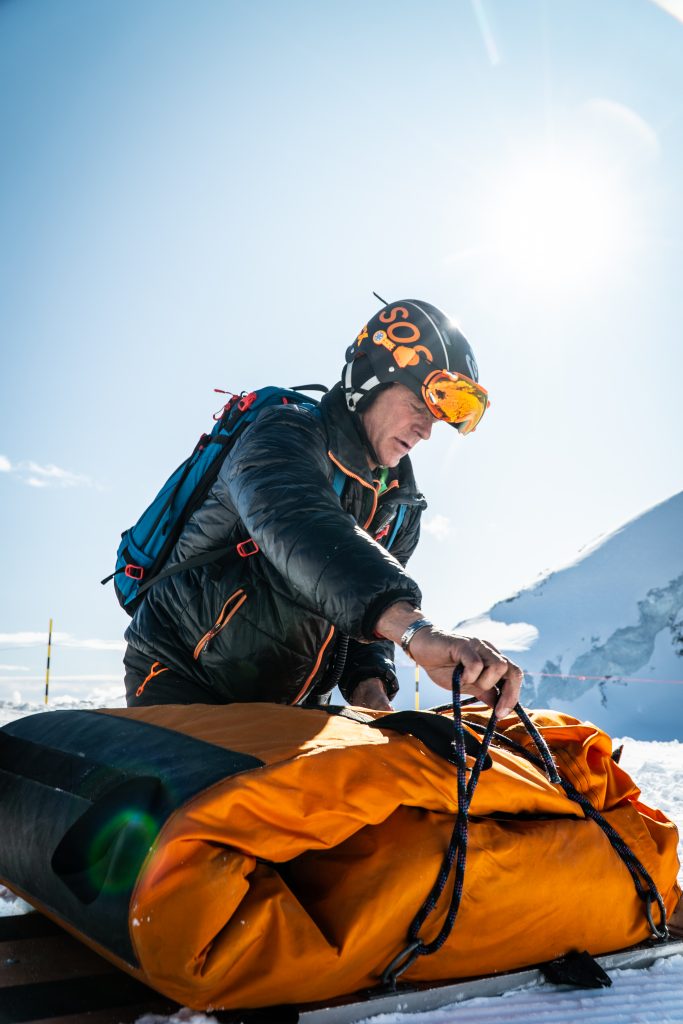
The ability to stay calm is indispensable in a job where the situation is constantly changing. And ‘routine’ is an alien concept to Bärti. The one fixed point in his schedule is at half-past four each morning when he is always in his office at the valley station. From there, he analyzes the previous night, and in particular the information collected by his snowcat drivers. He uses everything at his disposal to estimate the current avalanche risk and decides whether the ski area will open that day. The Swiss Avalanche Institute (SLF) makes a general recommendation for the area which serves as a guide. In addition to all of that, he sometimes draws on the experiences of his predecessor Dominik Kalbermatten, who boasts 25 years worth of valuable knowledge when it comes to assessing the snow situation in the area. Sometimes, Bärti has to increase the danger level above the SLF recommendation. As the head of mountain rescue for the high alpine ski resort Saas-Fee, he has a huge responsibility and faces several challenging decisions daily. A particular challenge of this ski resort is that it starts at an altitude where many others end, at 1,800 metres above sea level. The avalanche situation is rarely clear cut. As the leader of the mountain rescue team, he is responsible for the safety of the whole area. It would even be his duty to recommend total evacuation if the avalanche risk were to reach levels that extreme. He makes these decisions with the support of the Bergbahnen (lift company) management team as well as the crisis staff at the town hall.
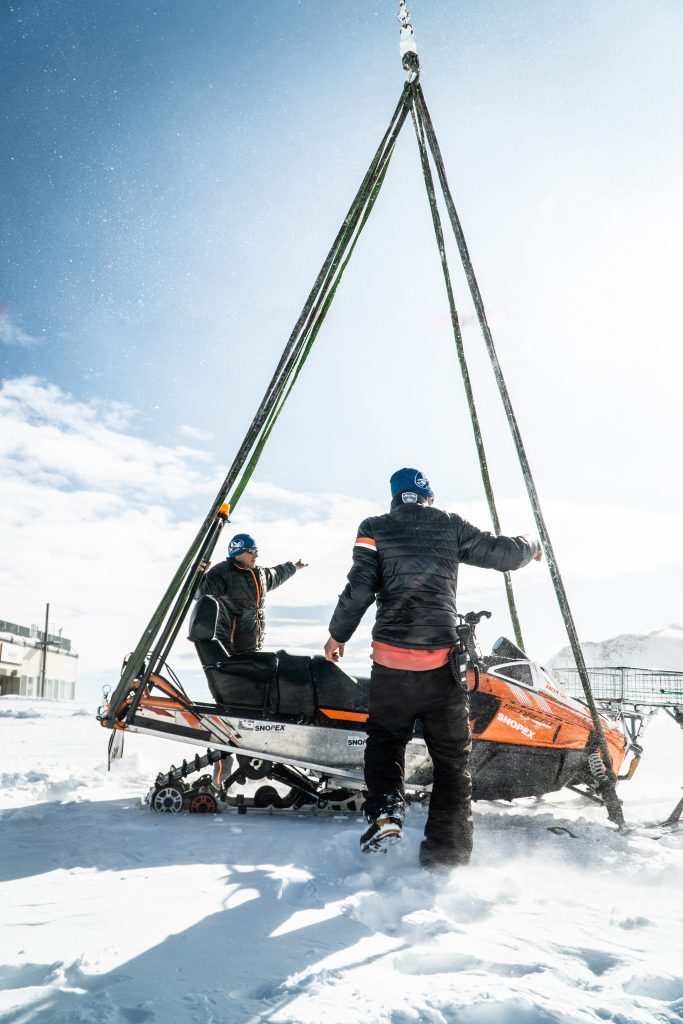
difficult-to-access terrain, Bärti calls in the helicopter. This is often the case when the
rescue requires heavy equipment. Image: Puzzle Media
After a heavy snowfall, the ski resort usually stays closed at the beginning of the day. It remains closed until Bärti and his team can detonate explosives to trigger controlled avalanches in highrisk areas, removing dangerous buildups of snow from the steepest slopes. They usually use a helicopter, or, when there is no other option, they ski tour and do the job by hand. When it comes to touring, Bärti needs to carry around 20 kilograms of explosives in his backpack. Is that not scary? “It‘s heavy,” he says with a wink. Once the snow loads on the steep slopes have been reduced, the avalanche situation can be reassessed. And when it reaches a reasonable level of risk, they can reopen the snowsports area. That doesn’t mean the risk has totally resolved, Bärti emphasises: “You should never lose your respect for the mountains. Avalanche danger prevails, as long as there is snow on the ground.”
Crevasses also present a huge risk factor. In the winter they lie hidden under a sheet of snow. Even Bärti, who knows the area and its terrain better than most, says that leaving the marked pistes on the glacier is too dangerous for him. He has witnessed far too many rescue missions for that. He recalls the time a young snowboarder fell into a crack below the Allalinhorn. Despite the efficient rescue effort, the snowboarder later died in the hospital. Such cases can really affect Bärti and the team. Especially when children are involved, he reflects, becoming more pensive. “During the rescues, in the moment, I’m on autopilot, just following my training to the word. But as soon as we’ve done what we can, that’s when I find myself brooding.” Regardless of whether he knows the victims personally, it still hits hard; they are people with futures ahead of them. The team come together to discuss experiences like this, to help them to come to terms with what they’ve seen. As the team leader, Bärti often seeks to start the conversation, usually sensing when someone else is dwelling on an incident.
since 2014. As of 2018 he has been head of mountain rescue. Image: Puzzle Media
Of course, there are some downsides. Patrollers need to do their job in all weathers. And even when it’s in the middle of a blizzard, with temperatures of -30 degrees and winds of 80 kilometres an hour, they still have to take off their gloves and detonate explosive charges to ensure everyone’s safety. And sometimes it takes a thick skin. Not all our guests are understanding when we have to close parts of the resort due to avalanche risks in the spring. But safety is everything for Bärti. It’s not up for discussion, even if it means losses for the Bergbahnen (lift company. Saas-Fee‘s piste patrol works closely with Air Zermatt. For complex rescues in difficult-to-access terrain, Bärti calls in the helicopter. This can be because the rescue requires heavy equipment; when it comes to rescues from crevasses, for example, they sometimes require winches, and rescues can last into the night, necessitating specialist lighting equipment. Hegner and his team also support Air Zermatt on numerous rescue efforts. When weather conditions are too dangerous the helicopter can’t always fly, and sometimes the search has to be called off. That is a particularly hard decision to make if they know that people are still missing. But bad weather does not stop Bärti and his team from working. If the lifts can’t run because of high winds, they use snowmobiles and even touring skis when needed. His patrols are always first to the scene of an accident, usually making the first diagnosis. “In 98 percent of cases, we get it right!” Bärti says, proud of his experienced team.
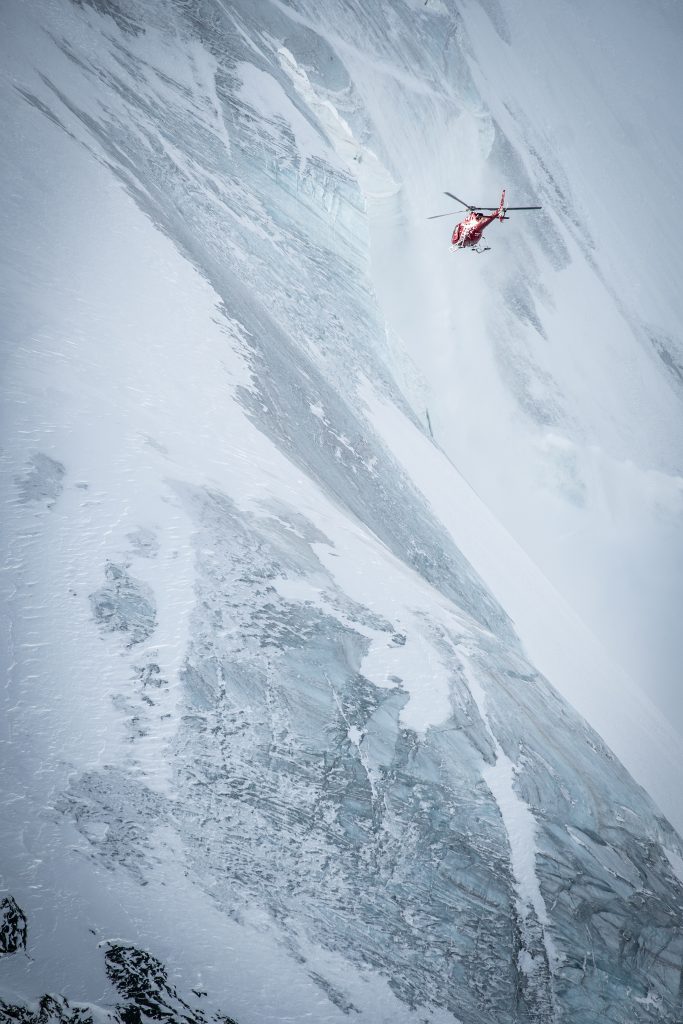
He started life as a farmer, before spending several years working on construction sites, installing windows. One day, by chance, Wendelin Keller, managing director of the Hoch-Ybrig ski resort in Znüni, asked Bärti if he would like to try life as a ski patroller. He was on the lookout for people for the winter, and Bärti thought, why not? With no knowledge of ski resorts and no particular interest in slope markers, he joined a training class in Arosa. He just wanted to ski as fast as possible, he admits with a laugh.
That said, Keller taught him what it takes to make considered decisions and ultimately to take responsibility for the ski resort. Bärti attributes the mental strength he currently exhibits in his role to Keller’s own tenaciousness. Suddenly his radio crackles, the helicopter pilot sounds impatient. “Understood, I‘ll bring the chainsaw with me,” Bärti responds as he hurries out. A mission awaits!

